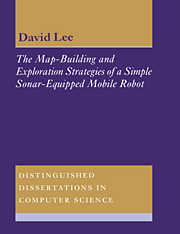 The Map-Building and Exploration Strategies of a Simple Sonar-Equipped Mobile Robot
The Map-Building and Exploration Strategies of a Simple Sonar-Equipped Mobile Robot Published online by Cambridge University Press: 05 March 2012
This chapter describes the design and implementation of a localisation scheme for ARNE. Without such a technique ARNE's estimated position, based only on odometry, would gradually diverge from its true position.
The essence of localisation is to match recent sensory information against prior knowledge of the environment. Some researchers build a ‘local’ map from the latest sensor readings and then look for the best match between the local map and a global map. The correspondence can then determine the robot's position in the global co-ordinate system. Elfes (1989) does this by seeking the best correlation between local and global probabilistic grids. Crowley (1989) and Drumheller (1987) both extract line segments from the sensor data and compare the position, orientation and length of the each line with lines in the global model.
The experiments in Chapter 6 showed that it is impossible to determine either the type or position of environmental features from a single scan of ARNE's sensor. It is therefore not possible to construct a local map from each viewpoint. Instead, the technique adopted in this thesis is to find immediate correspondences between sensor readings and known features, and to use the range readings to known objects to estimate ARNE's position. Published examples of this approach include Curran (1993), Leonard and Durrant-Whyte (1992), Rencken (1993) and Kleeman (1989). The process of matching ARNE's sensor readings to known objects has already been described in Section 7.3.
To save this book to your Kindle, first ensure [email protected] is added to your Approved Personal Document E-mail List under your Personal Document Settings on the Manage Your Content and Devices page of your Amazon account. Then enter the ‘name’ part of your Kindle email address below. Find out more about saving to your Kindle.
Note you can select to save to either the @free.kindle.com or @kindle.com variations. ‘@free.kindle.com’ emails are free but can only be saved to your device when it is connected to wi-fi. ‘@kindle.com’ emails can be delivered even when you are not connected to wi-fi, but note that service fees apply.
Find out more about the Kindle Personal Document Service.
To save content items to your account, please confirm that you agree to abide by our usage policies. If this is the first time you use this feature, you will be asked to authorise Cambridge Core to connect with your account. Find out more about saving content to Dropbox.
To save content items to your account, please confirm that you agree to abide by our usage policies. If this is the first time you use this feature, you will be asked to authorise Cambridge Core to connect with your account. Find out more about saving content to Google Drive.